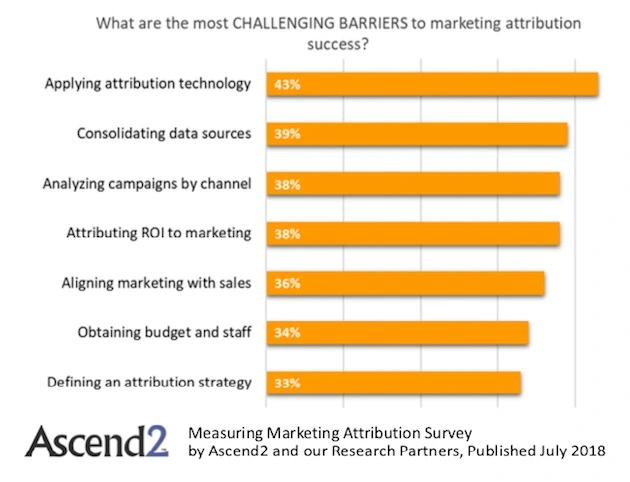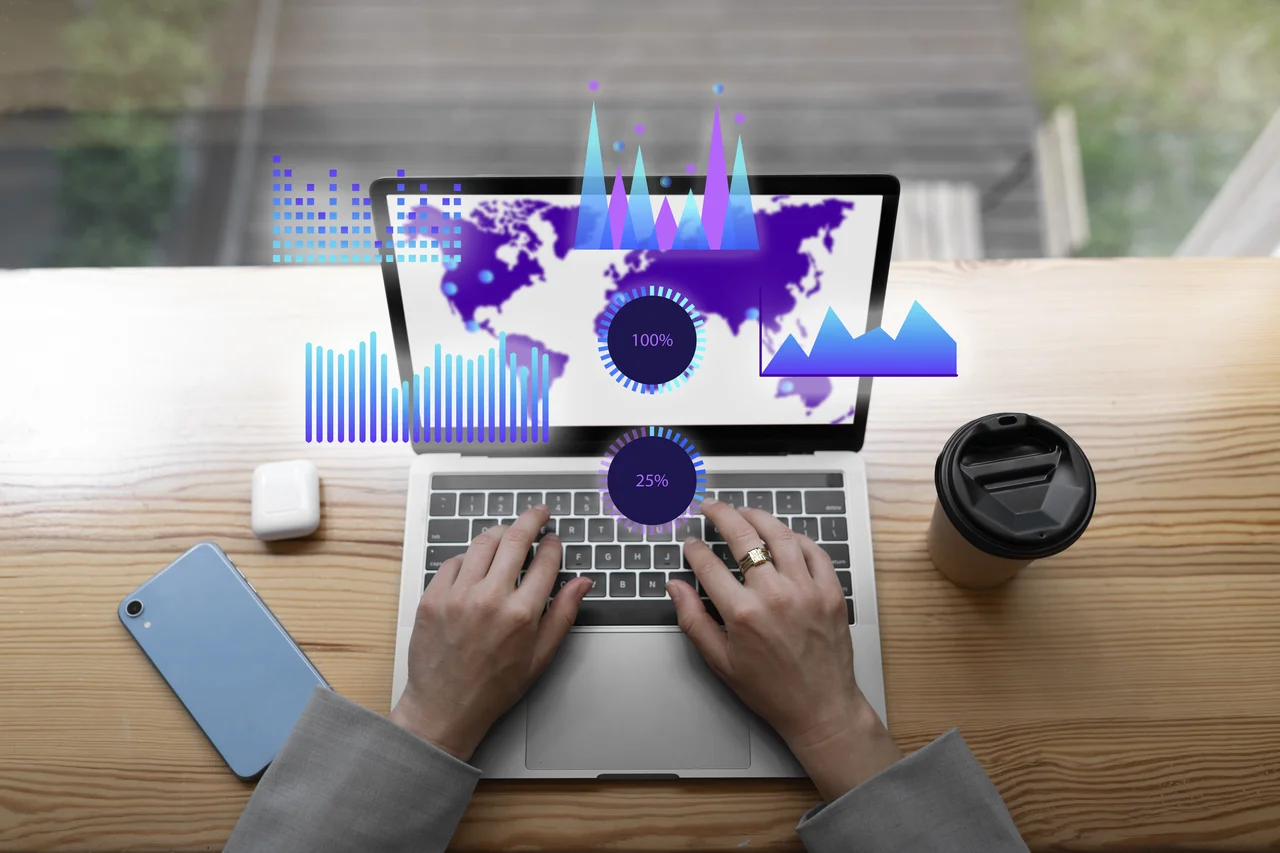Listen to article
“Are your marketing efforts paying off?” The question sounds simple, but identifying exactly which efforts are driving results is a challenge. In an era of multichannel campaigns and increasingly complex customer journeys, accurately measuring marketing attribution has become more critical than ever.
But are marketers really measuring the right things? The answer often depends on effectively adapting to new technologies and strategies. This article dives into essential statistics that highlight several key aspects of modern marketing attribution, from AI’s impact on content creation to channel diversification and the enduring role of SEO. We’ll explore how optimizing for metrics like click-through rates and understanding the influence of platforms like YouTube can refine your measurement and improve ROI.
How AI is Transforming Content Marketing and Shaping Attribution Models
Artificial Intelligence (AI) is no longer a nice-to-have in the marketer’s toolkit—it’s a game-changer that’s reshaping every stage of the content marketing funnel. From ideation to personalization, AI allows marketers to work smarter while unlocking new levels of precision in how we measure campaign effectiveness. But as AI streamlines the process of creating and distributing content, it also amplifies the need for marketers to rethink attribution strategies, ensuring credit is accurately assigned where it’s due in a multi-channel ecosystem.
- Enhanced Content Quality: A staggering 85% of marketers report that AI has significantly improved the quality of their content, leading to better engagement and audience resonance. Source
- Efficient Workflows: AI-powered tools have cut content development time nearly in half—reducing an average of 20 hours per week for 63% of content writers down to just 10 hours. This increased efficiency allows teams to focus more on refining attribution insights and optimizing strategy. Source
- Personalization at Scale: With 77% of marketers leveraging AI for personalization, it’s now easier than ever to deliver relevant, targeted content that speaks directly to specific audiences, potentially driving higher conversion rates. Source
- Idea Generation Made Easy: 43% of bloggers now rely on AI to spark fresh content ideas, helping them create more relevant and engaging material that aligns with their audience’s interests and drives attribution accuracy. Source
- Boosted ROI Performance: Nearly 68% of businesses have experienced increased ROI from content marketing by adopting AI tools, showcasing its potential to streamline workflows while improving marketing outcomes. Source
Key Takeaway
AI’s impact on content marketing is undeniable—it’s delivering higher-quality content, faster production cycles, and unparalleled personalization. But with this efficiency comes a more complex journey to measure and credit success. Traditional attribution models may not fully account for the nuanced role AI plays in crafting and distributing content. Marketers need to embrace both data-driven tools and human analysis to better connect the dots between AI-enhanced marketing activities and their influence on conversions.
Pro Tip:
Don’t let AI run on autopilot. Use insights from attribution data to refine how AI tools generate content, ensuring they align with your brand voice and customer needs. Additionally, consider adopting multi-touch attribution models that better capture the AI-driven touchpoints contributing to your audience’s buying journey.
Balancing AI Automation with Content Differentiation in B2B Marketing for Better Attribution
In the realm of B2B marketing, the challenge of standing out amidst a sea of similar content is ever-present. While many B2B marketers are turning to AI-powered automation to enhance their content strategies, it’s essential to ensure that this doesn’t come at the cost of content differentiation and thought leadership, both of which are crucial for effective marketing attribution. Here are some key statistics that highlight this balance.
- The Differentiation Challenge: 43% of B2B marketers find it challenging to differentiate their content from competitors, making it difficult to stand out and potentially skewing attribution data. Source
- Prioritizing AI Automation: Despite the differentiation challenge, 56% of B2B marketers are looking to prioritize AI-powered automation in 2025, indicating a strong interest in leveraging AI for efficiency, which can impact how marketing efforts are attributed. Source
- Adapting SEO Strategy for AI: When adapting SEO strategies for AI, 31% of B2B marketers are focusing more on user intent and answering questions, 27% are crafting more thought leadership content, and 22% are creating more conversational content. These strategies can influence which touchpoints get attributed with conversions. Source
- A significant 46% of B2B buyers consume an above-average amount of content while researching potential business solutions, highlighting the importance of a robust content strategy and accurate attribution across multiple touchpoints. Source
- Content marketing is most effective at the top of the funnel for B2B marketers, with 87% reporting it helps create brand awareness and 74% saying it generates demand/leads. This underscores the need to attribute value to top-of-funnel activities. Source
- Content marketing also plays a role in nurturing subscribers/audience/leads (62%), growing loyalty with existing clients/customers (52%), and generating sales/revenue (49%). Accurate attribution is crucial across all these stages. Source
- Only 37% say content marketing helps grow a subscribed audience, while a mere 9% report it reduces customer support costs. Understanding these limitations is important for realistic attribution expectations. Source
Key Takeaway
B2B marketers face the dual challenge of differentiating their content while leveraging AI for automation, all while striving for accurate marketing attribution. While AI can enhance efficiency and personalization, it’s crucial to focus on user intent, thought leadership, and conversational content to truly stand out and ensure that the right touchpoints are credited for conversions.
Pro Tip:
Invest in strategies that combine AI’s efficiency with unique, insightful content to maintain a competitive edge in the B2B landscape, and ensure that your attribution models accurately reflect the impact of these efforts.
How Channel Diversification Shapes Marketing Attribution Strategies
As the marketing ecosystem grows increasingly multifaceted, the sheer variety of channels available today has become both a blessing and a challenge. On one hand, a diversified channel strategy gives companies the opportunity to reach broader audiences. On the other, it makes assigning credit to the right touchpoints in the customer journey far more complex. With the rise of email, social media, in-person events, and virtual platforms, marketers need to take a more data-driven approach to their attribution efforts to avoid misallocating resources.
- Email (93%) and social media (92%) remain the leading channels B2B marketers use to distribute content, showcasing their undeniable importance in any attribution framework. Source
- Blog posts (79%), in-person events (56%), and virtual events/webinars (55%) are also integral to B2B content strategies, underscoring the diversity of touchpoints to track. Source
- High-performing B2B companies and agencies embrace all five major formats—email, social media, blogs, virtual, and in-person events—ensuring a well-rounded, omnichannel approach. Source
- On the other hand, underperforming brands tend to limit their scope, using only four content formats, signaling that narrowing channel options can negatively impact performance. Source
- Email, specifically, stands out as a revenue driver, with consumers spending 128% more on purchases initiated through this channel compared to others, making it an essential component for precise attribution models. Source
Key Takeaway
Having a diversified channel strategy is no longer optional—it’s a requirement for succeeding in today’s competitive B2B landscape. However, as the number of touchpoints grows, the need for advanced attribution tools becomes unavoidable. Without robust frameworks, marketers risk overvaluing or undervaluing key channels, potentially misdirecting budget and efforts. The takeaway? Diversification drives results, but only when paired with meticulous measurement and optimization strategies.
Pro Tip:
To stay ahead in a multi-channel world, consider adopting multi-touch attribution models that credit each touchpoint proportionally, rather than relying on outdated last-click or first-click models. Advanced tools like HubSpot, Windsor.ai, or Adobe Analytics can help you trace the customer journey and refine your strategy with unparalleled precision.
For those looking to fine-tune their multi-channel campaigns, integrating email marketing B2B lead generation techniques can amplify your outreach and ensure your attribution models capture the full impact of this high-performing channel.
How SEO Supercharges Traffic and Refines Attribution Models
Search Engine Optimization (SEO) is more than just a tactic—it’s a cornerstone of digital success. From driving massive traffic volumes to serving as the first step in countless customer journeys, SEO is integral to understanding how users interact with brands online. For attribution modeling, which seeks to credit the right channels for conversions, ignoring the power of SEO can lead to misleading insights and missed opportunities.
- SEO drives over 1,000% more traffic than organic social media, making it a dominant driver of discovery and engagement. This demonstrates the critical need to prioritize SEO in attribution strategies. Source
- 93% of online interactions begin with a search engine, showcasing its pivotal role in influencing customer decisions and touchpoints. Source
- Google is responsible for 63.4% of all US web traffic referrals, proving that a “Google-first” approach is essential to capturing a lion’s share of traffic and accurately attributing conversions. Source
Key Takeaway
Attribution modeling is only as accurate as the data it’s built on, and SEO plays a leading role in that foundation. With search engines acting as the gateway for most online interactions, optimizing for search not only drives unparalleled traffic but also creates a clearer path for tracking customer journeys. Whether it’s understanding how website visits convert into sales or uncovering which keywords generate the most qualified leads, SEO opens the door to more precise insights.
Pro Tip:
Look beyond rankings. Focus on creating search-friendly content that aligns with user intent and leverages high-traffic, low-competition keywords. Tools like SEMrush, Ahrefs, and Google Search Console are invaluable for monitoring performance and refining an SEO strategy that enhances your attribution efforts.
Rethinking CTR and Conversion Metrics for Smarter Attribution
When it comes to evaluating the impact of advertising campaigns, Click-Through Rate (CTR) and conversions are often top of mind for marketers. They provide a snapshot of how well your ads are resonating with your audience and driving action. However, these metrics, while essential, only scratch the surface of attribution. To truly understand the ROI and effectiveness of your efforts, it’s important to view them in the larger context of audience behavior, touchpoints, and brand perception.
- Ads appearing on the first page of Google search results average a 3.16% CTR. While this indicates strong ad placement and relevance, it doesn’t capture the full customer journey. Source
- The average conversion rate for ads on Facebook across all industries is 9.21%. This demonstrates the platform’s potential for generating leads, but attributing value to specific buyer stages remains complex. Source
- A personalized PPC landing page can boost effectiveness by 5%. Customization not only improves the user experience but also makes it easier to connect conversions to specific campaigns. Source
- Visitors who click on ads are twice as likely to convert compared to those who arrive via organic search. This underscores the value of paid search in influencing purchasing behavior. Source
- Over 25% of users click on sponsored search ads because they recognize the brand. This means brand familiarity can strongly influence performance metrics and should be factored into attribution strategies. Source
Key Takeaway
While CTRs and conversion rates are undoubtedly important, they rarely tell the full story of campaign success. For instance, a campaign with lower CTR but higher intent-driven conversions may be far more effective than one with a high number of unqualified clicks. Additionally, brand recognition and emotional resonance are qualitative factors that can drive clicks and conversions—even if they’re harder to measure in traditional attribution models. The key is to balance quick wins like CTR with long-term metrics such as customer lifetime value (CLV) and brand equity in your attribution strategies. It’s also crucial to identify and invest in marketing channels with the highest conversion rates—such as paid search, remarketing, and email—so your attribution model reflects not just activity, but real outcomes.
Pro Tip:
To get a more comprehensive view of what’s driving results, combine quantitative metrics like CTR and conversions with qualitative data such as post-click behavior and customer feedback. Leverage tools like Google Analytics 4 or attribution software to map the touchpoints that lead to conversions and optimize your campaigns accordingly.
PPC in Lead Generation and Offline Conversions: Insights for Smarter Attribution

Source: MarketingProfs
In a marketing landscape where every dollar matters, PPC (pay-per-click) advertising isn’t just a tool for driving traffic—it’s a catalyst for measurable, high-intent actions both online and offline. From sparking meaningful customer interactions to directly influencing offline conversions like phone calls, PPC is a cornerstone of effective attribution strategies. By tapping into its potential, marketers can bridge the gap between digital ads and real-world results, ensuring no conversion goes unaccounted for. Here are some key statistics that shed light on PPC’s impact:
- High-Intent Search Ad Clicks: A remarkable 65% of high-intent searches culminate in an ad click, proving how PPC effectively targets and captures engaged prospects. This demonstrates why PPC is indispensable in accurate attribution models. Source
- Offline Engagement Through Ad Interaction: Customers who engage with a PPC ad are 52% more likely to call the business directly, showing a clear link between digital ads and offline actions. For marketers, this highlights the need to track these offline conversions as part of the customer journey. Source
- Boost in Landing Page Performance with Call Tracking: Introducing call tracking to PPC campaigns can more than double landing page conversions. This reinforces the importance of attributing offline interactions back to specific digital efforts, creating a more complete view of campaign performance. Source
Key Takeaway
PPC advertising does far more than drive clicks—it connects the dots between online engagement and offline outcomes. The stats reveal how PPC can influence not just website visits but real-world actions like phone calls, making it an essential part of any holistic attribution strategy. When paired with expert PPC services, these campaigns become even more powerful—driving high-intent traffic, refining targeting precision, and optimizing ROI across channels. By tracking offline interactions, businesses can close attribution gaps and uncover valuable insights into customer behavior.
Pro Tip:
Incorporate advanced call tracking tools into your PPC campaigns to not only amplify conversions but also gain detailed insights into call durations, sources, and even call outcomes. By seamlessly integrating these insights into your attribution model, you’ll uncover the true ROI of your digital efforts.
YouTube’s Power in Purchase Decisions and Multi-Touch Attribution
As the digital consumer journey becomes increasingly visual, YouTube stands out as a powerhouse in influencing purchase behavior. Beyond being a platform for entertainment, YouTube has transformed into a critical touchpoint where consumers discover, evaluate, and decide on products. For marketers looking to perfect their multi-touch attribution strategies, understanding YouTube’s role is no longer optional—it’s essential. Let’s dive into the numbers that highlight its influence:
- Turning Discoveries into Purchases: Over 40% of global shoppers have purchased products after discovering them on YouTube. This underscores the platform’s role as more than just a source of inspiration—it’s a direct sales driver. Source
- The #1 Social Purchase-Driver: Among social media platforms, YouTube leads as the top purchase-driver, showing its unmatched ability to convert engagement into action. Source
- Faster Purchase Decisions: A remarkable 87% of users report that browsing or shopping on YouTube helps them make purchase decisions more efficiently. The platform not only informs but also streamlines the decision-making process, adding immense value to attribution models. Source
- Preferred Video Platform: With 83% of global consumers favoring YouTube for video content, it’s clear that the platform’s reach and influence are unparalleled in video marketing. Source
Key Takeaway
YouTube isn’t just another marketing channel—it’s a pivotal player in shaping the customer journey. From product discovery to accelerating purchase decisions, its unparalleled reach and trustworthiness make it a cornerstone for any multi-touch attribution strategy. Failing to incorporate YouTube’s impact into your attribution models could mean missing out on crucial insights about your audience’s purchase behavior.
Pro Tip:
Maximize YouTube’s potential by crafting product-focused, value-driven content that resonates with your target audience. Tutorials, product reviews, and behind-the-scenes videos can help build trust and guide viewers toward conversion. Don’t forget to integrate video view data into your attribution models to capture the full scope of YouTube’s influence on your sales funnel.
To build a comprehensive marketing strategy that fully considers YouTube’s impact, businesses should also explore broader digital marketing strategies for small businesses. These strategies can help ensure that video marketing efforts fit seamlessly into a cohesive plan for growth and visibility.
Conclusion
As the digital marketing landscape evolves, the complexity of marketing attribution grows. From the rise of AI in content creation to the pivotal role of SEO, PPC, and channel diversification, understanding how to measure the effectiveness of each touchpoint is more important than ever. AI is enabling marketers to create more personalized, high-quality content at scale, but it also demands more nuanced attribution models to track ROI. Similarly, while SEO drives massive amounts of traffic and YouTube accelerates purchase decisions, these channels require strategic tracking to ensure their contributions are accurately captured.
The balancing act of automating processes with AI while maintaining content differentiation, or leveraging multiple channels without losing sight of attribution accuracy, is no small feat. Marketers must adopt a holistic approach, integrating data-driven insights with creative strategies to maximize the value of their efforts. Whether it’s tracking offline conversions from PPC campaigns or evaluating YouTube’s role in a multi-touch journey, precision in attribution is the key to optimizing performance and driving sustainable growth.
Ready to boost your traffic and grow your website? Your customers are looking for you, and our SEO services can help you be found across search engines. Let’s build an attribution strategy that works for your brand.
About Marketing Attribution Statistics: Are We Measuring the Right Metrics?
This guide was written by the Scopic Studios team and reviewed by Araksya Hakobjanyan, SEO Lead at Scopic Studios.
Scopic Studios delivers exceptional and engaging content rooted in our expertise across marketing and creative services. Our team of talented writers and digital experts excel in transforming intricate concepts into captivating narratives tailored for diverse industries. We’re passionate about crafting content that not only resonates but also drives value across all digital platforms.
Note: This blog’s feature image is sourced from Freepik.














































































































































































































































